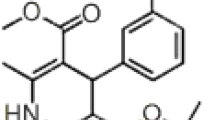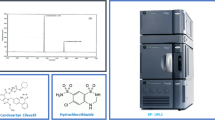Abstract
To assay the dissolution samples of a drug product from several sources, a simple but broadly applicable analytical method is always desired. For the liquid-filled cyclosporine capsules, while analyzing the dissolution samples, the current compendial and literature HPLC methods have been found to be inadequate to provide satisfactory separation of the drug and the excipient peaks. Accordingly, a suitable isocratic reverse-phase HPLC method was developed for the analysis of dissolution samples of liquid-filled cyclosporine capsules. The method successfully separated the cyclosporine peak from the interfering chromatographic peaks of the excipients. The method was validated according to the ICH and FDA guidelines. Specificity, selectivity, linearity, accuracy, precision, and robustness were established over 3 days as part of method validation. Additionally, the degradation kinetics of cyclosporine in dissolution media was determined. Cyclosporine degradation followed a zero-order kinetics in the dissolution media with the respective rate constants of −3.5, −1.5, and −0.3%/h at 37°C, 25°C, and 10°C.








Similar content being viewed by others
References
Talal N. Cyclosporine as an immunosuppressive agent for autoimmune disease: theoretical concepts and therapeutic strategies. Transplant Proc. 1988;20(3 Suppl 4):11–5.
D. Tedesco, L. Haragsim. Cyclosporine: a review. Journal of Transplantation 2012;230386. 2012.
Drugs@FDA. 2012.
Mithani SD, Bakatselou V, TenHoor CN, Dressman JB. Estimation of the increase in solubility of drugs as a function of bile salt concentration. Pharm Res. 1996;13(1):163–7. Springer Netherlands.
Friis GJ, Bundgaard H. Kinetics of degradation of cyclosporin A in acidic aqueous solution and its implication in its oral absorption. Int J Pharm. 1992;82(1–2):79–83.
Kahan BD, Grevel J. Optimization of cyclosporine therapy in renal transplantation by a pharmacokinetic strategy. Transplantation. 1988;46(5):631–44.
Grevel J, Nuesch E, Abisch E, Kutz K. Pharmacokinetics of oral cyclosporin A (Sandimmun) in healthy subjects. Eur J Clin Pharmacol. 1986;31(2):211–6.
Kahan BD. Therapeutic drug monitoring of cyclosporine: 20 years of progress. Transplant Proc. 2004;36(2, Supplement):S378–91.
Honcharik N. The effect of food on cyclosporine absorption. Selected papers from the Canadian Consensus Meeting on Cyclosporine Monitoring. Clin Biochem. 1991;24(1):89–92.
Sall K, Stevenson OD, Mundorf TK, Reis BL. Two multicenter, randomized studies of the efficacy and safety of cyclosporine ophthalmic emulsion in moderate to severe dry eye disease. Ophthalmology. 2000;107(4):631–9.
Tarr BD, Yalkowsky SH. Enhanced intestinal absorption of cyclosporine in rats through the reduction of emulsion droplet size. Pharm Res. 1989;6(1):40–3. Springer Netherlands.
Keown P, Niese D. Cyclosporine microemulsion increases drug exposure and reduces acute rejection without incremental toxicity in de novo renal transplantation. Kidney Int. 1998;54(3):938–44.
Tredger JM. Using cyclosporine neoral immediately after liver transplantation. Therapeutic Drug Monitoring 1995;17[6]
Bowers LD, Mathews SE. Investigation of the mechanism of peak broadening observed in the high-performance liquid chromatographic analysis of cyclosporine. J Chromatogr A. 1985;333(0):231–8.
Zidan AS, Sammour OA, Hammad MA, Megrab NA, Habib MJ, Khan MA. Quality by design: understanding the product variability of a self-nanoemulsified drug delivery system of cyclosporine A. J Pharm Sci. 2007;96(9):2409–23. Wiley Subscription Services, Inc., A Wiley Company.
Kumar M, Singhal SK, Singh A. Development and validation of a stability indicating HPLC assay method for cyclosporine in cyclosporine oral solution USP. J Pharm Biomed Anal. 2001;25(1):9–14.
ICH Q2(R1) Validation of analytical procedures: text and methodology;1995.
Hansch C, Leo A, Hoekman DH. Exploring QSAR. Washington, DC: American Chemical Society;1995
Acknowledgments
This project was funded by regulatory science and review enhancement (RSR) funding from FDA, and was supported in part by an appointment to the ORISE Research Participation Program at the CDER administered by the Oak Ridge Institute for Science and Education through an agreement between the U.S. Department of Energy and CDER.
Disclaimer
The findings and conclusions in this article have not been formally disseminated by the Food and Drug Administration and should not be construed to represent any Agency determination or policy.
Author information
Authors and Affiliations
Corresponding author
Rights and permissions
About this article
Cite this article
Xu, X., Gupta, A., Faustino, P. et al. Development and Validation of a HPLC Method for Dissolution and Stability Assay of Liquid-Filled Cyclosporine Capsule Drug Products. AAPS PharmSciTech 14, 959–967 (2013). https://doi.org/10.1208/s12249-013-9983-8
Received:
Accepted:
Published:
Issue Date:
DOI: https://doi.org/10.1208/s12249-013-9983-8




